Preview in new tab
At a glance
Expert’s Rating
Pros
- Bose’s immersive audio processing works on any and all content
- Industry-leading active noise cancellation
- Comfortable and secure fit
- Automatic customized sound optimization
Cons
- Mediocre battery life when immersive audio is engaged
- Wireless case charging costs extra
- Immersive audio sometimes buries good stuff
- Active noise cancellation cannot be turned off
Our Verdict
Bose QuietComfort Ultra Earbuds bring sonic immersion and engagement to an already solid in-ear audio foundation.
Best Prices Today: Bose QuietComfort Ultra Earbuds
Just like car makers, earbud and headphone manufacturers feel compelled to upgrade their perfectly good models every year. In my Bose QuietComfort Earbuds II review just over year ago, I gushed how they won my heart with bliss-inducing audio performances and world-quieting active noise cancellation. Yet, Bose went back to the drawing board for a refresh, producing the Bose QuietComfort Ultra Earbuds reviewed here.
Ironically, I also said of the earlier model that they were so full of innovation that they deserved a new name. And I guess “Ultra” is an improvement over Roman numerals.
In any event, you’ll need more than a casual glance to separate these newbies from last-year’s model, there’s just a touch of cosmetic enhancement—contrasting metal on the name plate/touchpad—and a tighter locking notch for the ear-hook stabilizers.
You owe yourself a listen to the Bose QuietComfort Ultra Earbuds.
Bose’s engineers have been a lot busier under the hood. The microphone system on the Ultra has been reworked to better filter out wind noise and improve your speaking voice during calls in locations where there’s lots of other noise. They did the job well on kitchen calls with the TV blasting four feet away.
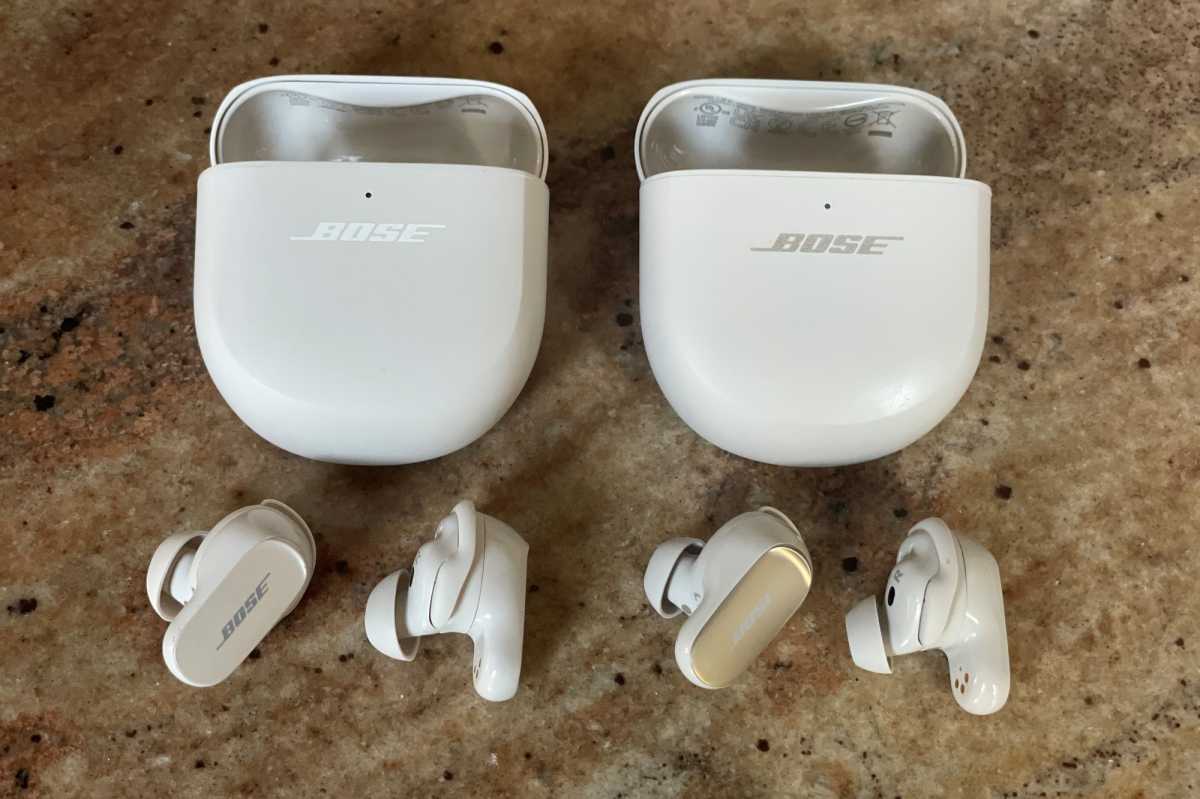
Can you tell which buds are last year’s Bose QC Earbuds II and which are the new QC Ultra Earbuds? The new ones are on the left.
Jonathan Takiff/Foundry
More exciting and buzzworthy—literally and figuratively—Bose has introduced an extra-powerful audio-processing enhancement called “immersive audio.” When engaged, it works all kinds of math magic on your music. A first cousin to artificial intelligence, immersive audio analyzes and tweaks elements of the incoming digital sound stream to make component parts separate, pop, and sizzle; lending extra clarity, vitality, and three-dimensionality to the music.
This review is part of TechHive’s in-depth coverage of the best noise-cancelling headphones.
How intense is Bose’s processing? Engaging the feature with a tap on one of the buds or via the Bose Music app reduces battery run time from 6 hours to 4, according to Bose (although I’ve squeezed out almost 5 hours of play time with it enabled. Then again, I also kept the volume fairly low, peaking at around 60dB.)
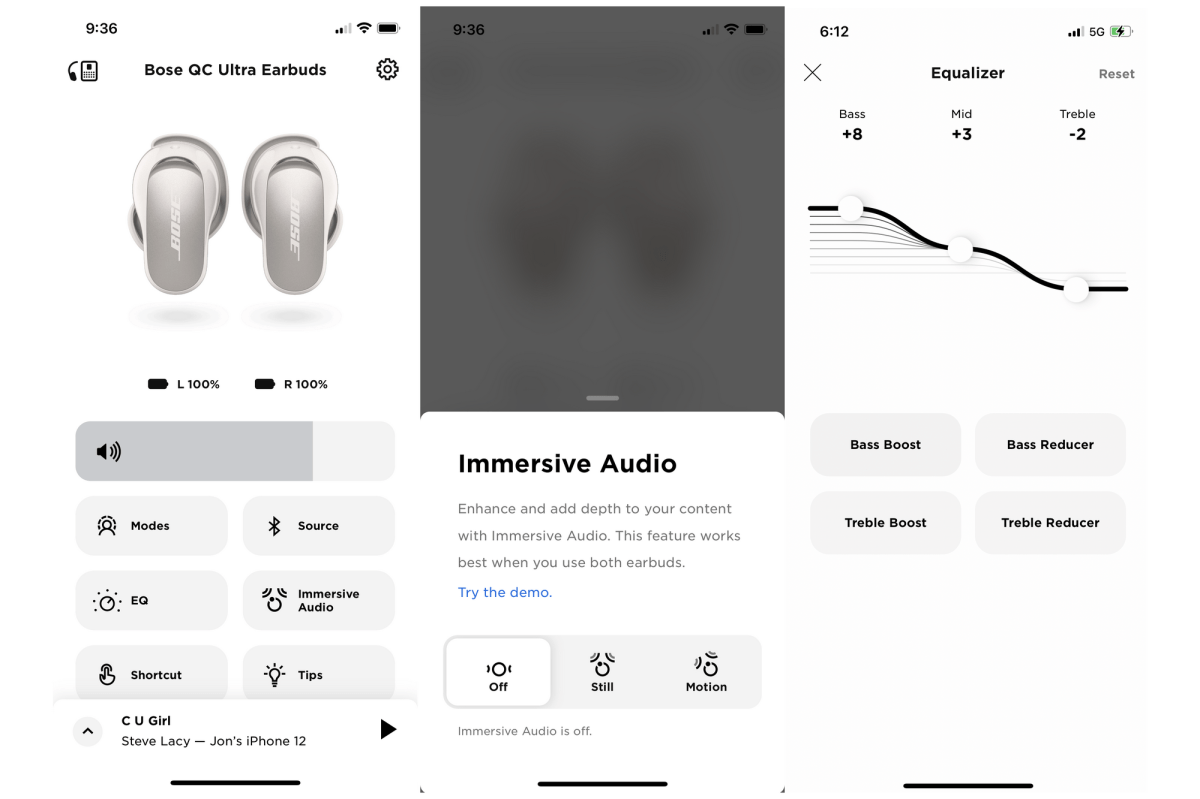
The Bose Music app offers fine control over all the Bose QC Ultra Earbuds’ features and functions (except the ability to turn off ANC).
Jonathan Takiff/Foundry
If you’re wondering about the difference in run time with active noise cancellation (ANC) enabled and disabled, there isn’t any—because you Bose doesn’t let you turn off ANC on the QuietComfort Ultra Earbuds. After decades of pioneering and refining the processing, Bose has made its ANC so clean, efficient, and neutral that using it doesn’t entail any tradeoffs in audio performance, as you’ll encounter with some rival buds and headphones. Still, there is a downside to Bose’s decision: You won’t be able to use them continuously all day long—i.e., for 8 to 10 hours on a charge, as some competitors boast.
Bose has its own immersive audio tech
Immersive and spatial audio technologies like Dolby Atmos and Sony 360 Reality Audio have generated plenty of excitement in the music industry. Record labels have been making substantial efforts to remix their catalogs for playback on subscription streaming services like Apple Music and Amazon Music Unlimited, which in turn require subscribers to have playback hardware capable of decoding those bitstreams: Speakers and headphones from the likes of Apple, Sony, Sonos, and others.
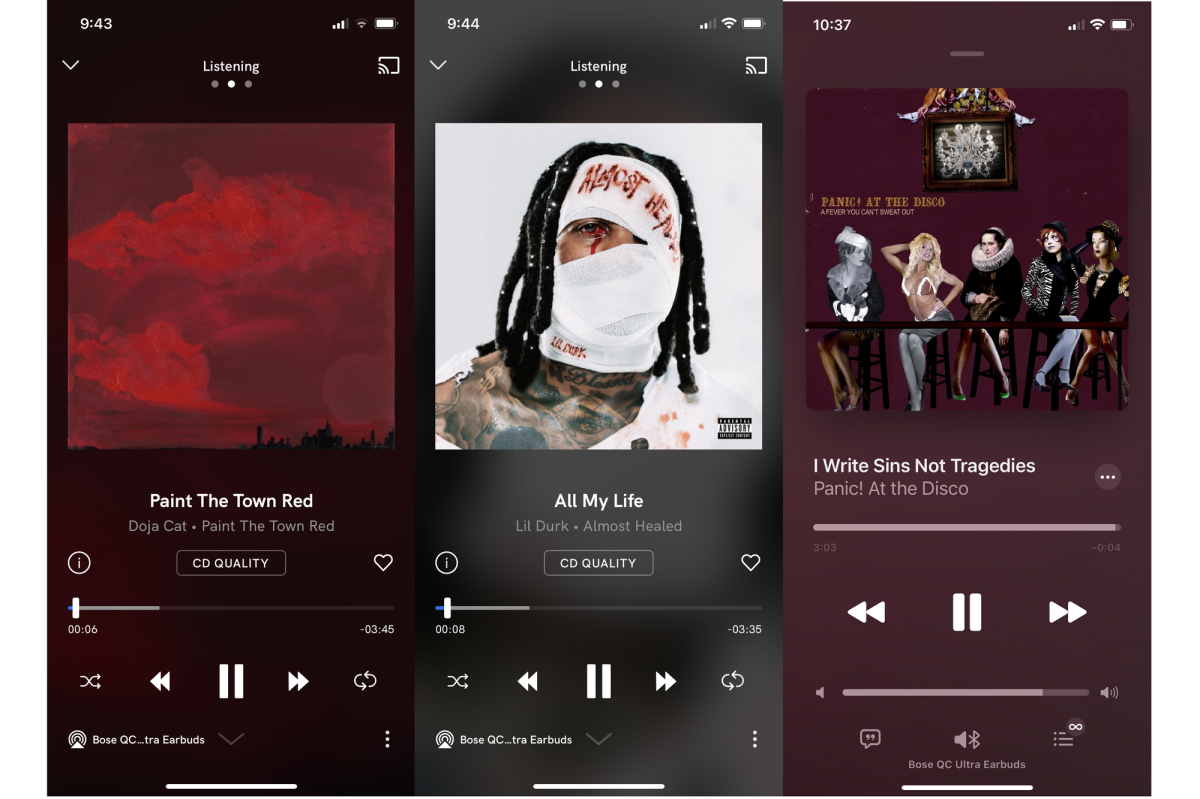
Some music was improved by Bose’s immersive audio processing.
Jonathan Takiff/Foundry
The Bose product team looked uncomfortable during a recent press briefing when I pondered aloud if their immersive audio processing might somehow be compatible with Dolby Atmos or Sony 360 Reality Audio. The answer was an emphatic no. Bose hasn’t reverse-engineered either of those patented, trademarked, and expensive-to-license audio-mapping technologies, and the company makes no claims of compatibility with them.
What they do acknowledge is that their homegrown processing achieves similarly edgy effects with all manner of stereo content, bringing previous outsiders like Spotify and Pandora to the spatial audio party. It’s accomplished, I’m thinking, with such tricks as signal phasing, timing, frequency tweaking, and good old-fashioned volume boosts programmed into the Qualcomm Snapdragon QCC5181 chipset that powers the QuietComfort Ultra Earbuds. You’ll find the same silicon in the Bose QuietComfort Ultra Headphones that are scheduled to ship later in October.
Bose’s immersive audio efforts benefit from an integrated gyroscope and accelerometer that perform onboard head-tracking, similar to Apple’s 2nd-gen Airpods Pro. Bobbing and weaving your head puts the music in motion, shifting the emphasis from the vocalist in the center of the soundstage to the left-center guitarist and then over to the right-side bassist and piano player as you move your head about.

But Bose’s technology didn’t improve every audio experience.
Jonathan Takiff/Foundry
Confusingly, this head-tracking interaction and engagement occurs when immersive audio in the Bose app is set to “Still.” Bose is telling you here that the music mix will stay locked in its initial position, so your shifting head and ear-orientation can then alter the sound field perspective, akin to what you’ll visually experience when you don augmented-reality glasses and turn around in a virtual room. If you’d prefer to have the music travel with you in a stable fashion—i.e., the normal experience of wearing conventional headphones—use the “Motion” setting when you are in motion.
Bose delivers spatialization magic shockingly well most of the time, but it’s not foolproof. Signal dropouts throw off playback more than I’d like, and I sometimes felt it made the wrong choice, followed the wrong players and stepped on the wrong toes to make the music sound more spacious. That’s a problem sound buffs are less likely to encounter with hardware and software that’s married to each other, a la Dolby Atmos or Sony 360 Reality Audio.
The Taylor Swift track “Cruel Summer,” for example, felt too far forward with Bose’s immersive audio turned on, because the processing tamped down the throbbing electronic keyboard textures. Likewise, disabling that processing made Icelandic jazz chanteuse Laufey’s singing breathier and more intimate—my preference—on her new set Bewitched. And Fall Out Boy’s updated lyrics for their cover of Billy Joel’s “We Didn’t Start the Fire” were sharper and clearer without Bose’s processing.
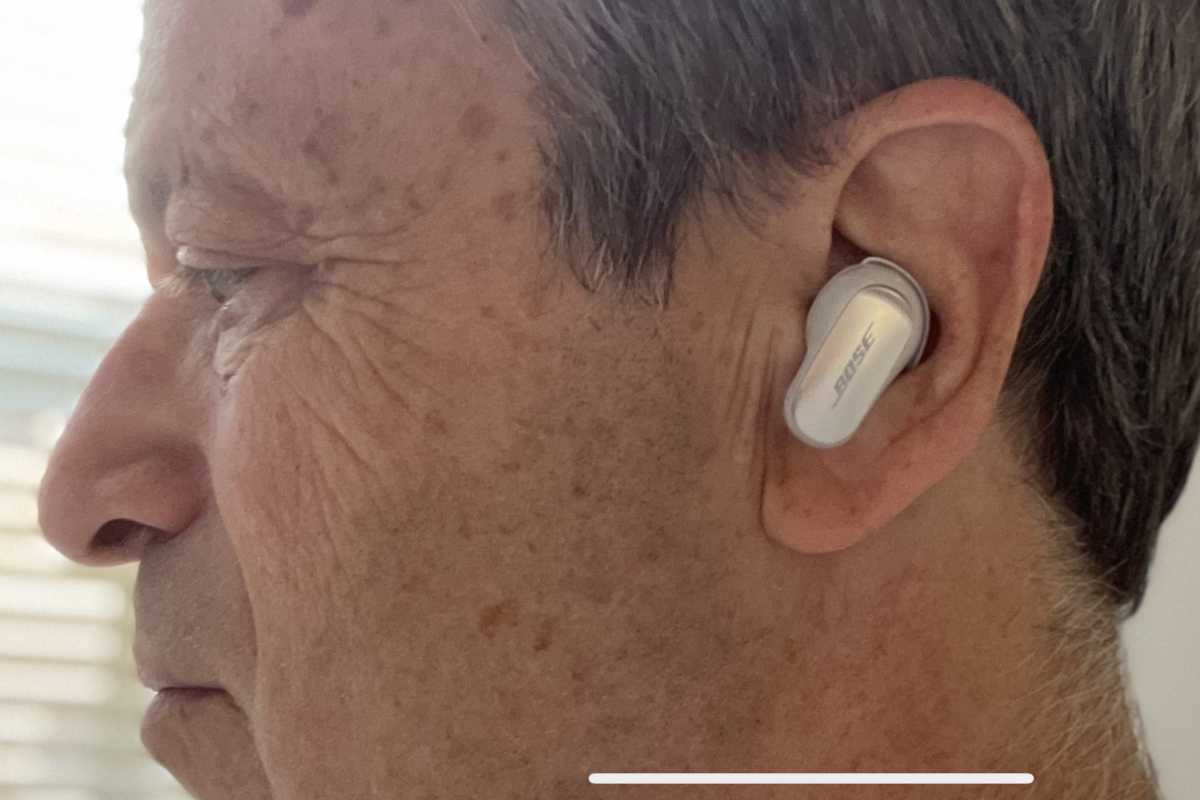
The Bose QuietComfort Ultra Earbuds provide a comfortable but secure fit in your ears.
Jonathan Takiff/Foundry
On the other side of the aisle, I much preferred Doja Cat’s “Paint the Town Red” in Bose’s immersive audio, because the processing emphasizes a memorable trumpet part sampled from the Dionne Warwick hit “Walk On By.” By the same token, immersive audio processing renders the lyrics to the Lil Durk (with J.Cole) track “All My Life” more discernable and vivid. And Panic! At the Disco kicked butt better with IA on the rude awakening “I Write Sins Not Tragedies.”
Immersive Audio also worked its charms on, ahem, serious music: Switching to a Saturday-afternoon opera broadcast (from China) of Donizetti’s The Daughter of the Regiment on VPR Classical, the show host’s spoken introduction sounded gawd-awful with spatial mode engaged—it sounded like she was talking in a cave. But once the performance got underway, I was generally glad the immersive audio option was turned on.
In a back-and-forth comparison, I experienced a much better sense of orchestral presence, although the concert bassist’s notes were oddly diminished. And in my mind’s eye, I could visualize the vocal soloists and chorus spread over a much larger, deeper soundstage. Also piling on the you-are-there sensation, immersive audio accentuated the stomping of performers’ feet and even the creaking sounds of scenery being hauled up and down from the rafters.
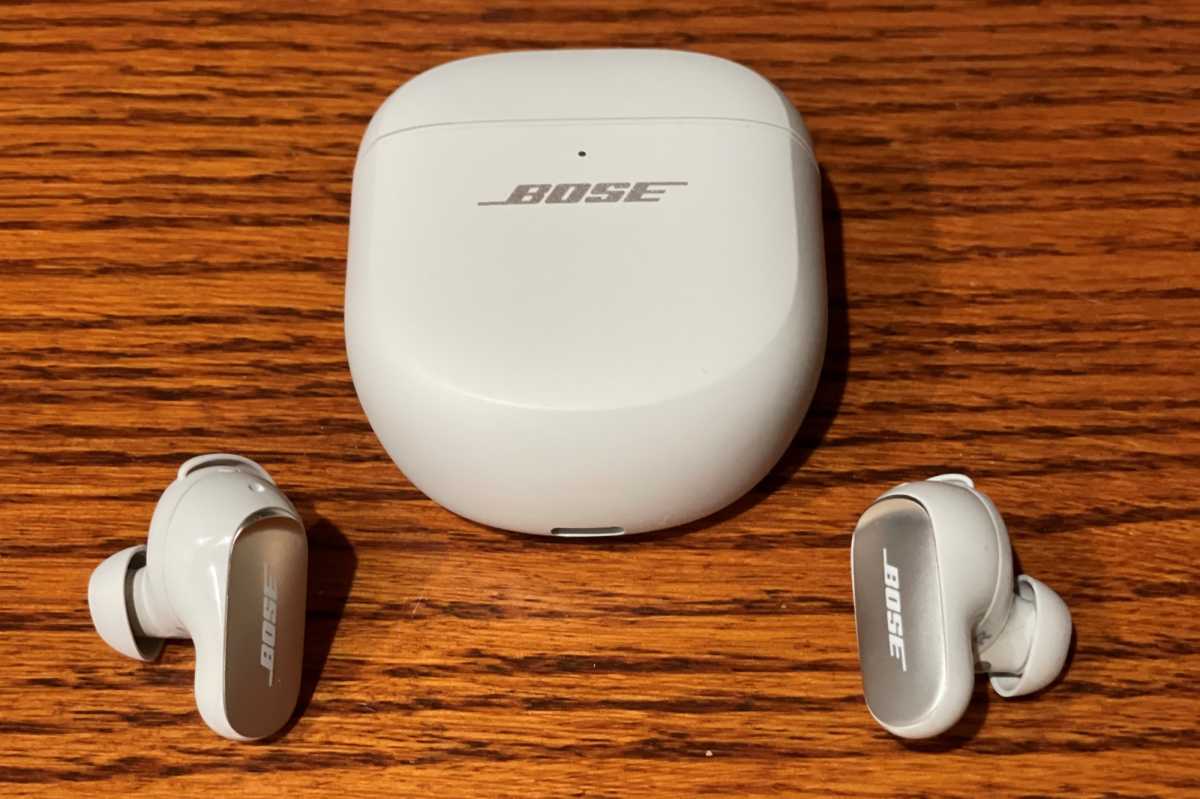
If you want a wireless charging option for the Bose QuietComfort Ultra Earbuds’ case, you’ll need to spend another $49 for an add-on silicone cover.
Jonathan Takiff/Foundry
As for that gone-missing bass, I could readily compensate by going into the app’s EQ settings and creating a new frequency curve—bumping the bottom-end and mid-range frequencies up. Unfortunately, I couldn’t figure out how to lock-in this new EQ as part of a Customized Mode, for easy-tap access on a bud or in the app, as I can to switch between Immersive Audio modes (Off/Still/Motion) and active noise-reduction options (Quiet/Aware/Immersion/Custom).
Some things haven’t changed
In the “if it ain’t broke, don’t don’t fix if it” department, the Bose QuietComfort Ultra Earbuds still maximize the maker’s superior noise cancellation with Custom Tune sound calibration, which triggers a sampling tone whenever you put them on. And you can still run the show with variable-length taps or easy volume slides on the earbuds’ touch-sensitive surfaces. And when you walk in the door, Bose’s Simple Synch technology allows you to pair these buds with select smart soundbars and speakers for automated music handoffs.

The vast majority of the improvements over last year’s QC earbuds (right) are under the hood.
Jonathan Takiff/Foundry
The Bluetooth 5.3 radio in the Qualcomm chipset hasn’t yet added support for next-gen Bluetooth tech—think LE Audio, for Auracasting from one source to many bud wearers—or the more-efficient LC3 audio codec. But the buds are “upgradeable if the technology wins more support,” said a Bose source. And the chipset does currently offer support for the lossless and hi-res, low-latency aptX Adaptive audio codec and Swift Pair tools available on Android devices. Apple users must make do with support for the AAC codec.
The buds and carry/recharging case) look the same as the QC II, although the new model’s White Smoke color option is slightly grayer compared to the earlier Soapstone white. The black version remains—well, black.
Bose’s case still lacks a wireless charging feature, but it will soon offer a slip-on silicone cover ($49) that transfers power from a Qi charging pad. Also status quo: middling IPX4 water resistance.
Should you buy Bose QuietComfort Ultra Earbuds?
If you own Bose QuietComfort Earbuds II, you should stick with them, as their core, top-shelf musicality and noise reduction attributes haven’t been improved on more than a smidgeon.
But if you’re looking to move up from a lesser species of buds, or you’re craving bigger, more three-dimensional sound from otherwise excellent streaming services that haven’t signed up with Dolby Atmos or Sony 360 Reality Audio–Spotify, Pandora, TuneIn, Qobuz, Sirius/XM, et al—you owe yourself a listen to the new Bose QuietComfort Ultra Earbuds.

